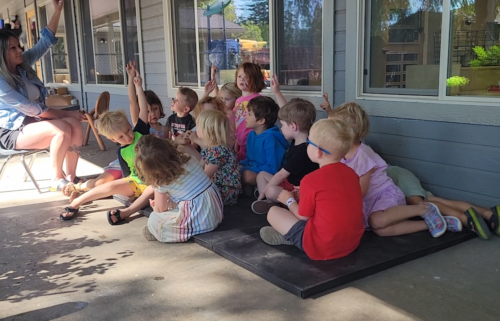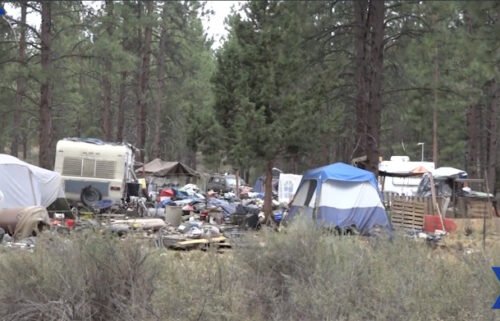Former school building turned into apartments

Tina Amble (left) shows off her new apartment that is in a former second-grade classroom of a building that from 1968 to 2018 was home to Arena Elementary School.
By Barry Adams
Click here for updates on this story
ARENA, Wisconsin (madison.com/Wisconsin State Journal) — The desks are gone, along with the students, teachers, playground equipment and concerts.
The 2018 closure of the elementary school was a blow to this eastern Iowa County village, and required students here to be bused to Spring Green.
Declining enrollments, increased costs and maintenance issues forced the hand of the River Valley School District, which in 2017 also shuttered its elementary school in Lone Rock for the same reasons.
But on Saturday, the former Arena Elementary School was full of life.
Some showed off their new apartments, constructed in former classrooms and with Amish-built kitchen cabinets.
In the gymnasium, students of Hardcore Tumbling & Gymnastics did flips on mats, swung on bars and tried to keep their feet on balance beams. The Arena Historical Society is set up in the former kitchen to show off its collection, while the former school office and nurse’s station are the new home of the Arena Food Pantry.
A more than $1 million project by a pair of Arena developers has resurrected the former school building and has helped remove some of the sting that has lingered in this village over the past three years.
“I think they’re trying to bring the community back into the building, and that’s the most important thing that has happened here,” said Ray Porter, whose family tree in Arena goes back to the 1840s. “For these guys to take this venture on is really important to the community. We had lost some of our identity.”
The project The guys Porter is talking about are Sean Crook and Rick Kerska, two union ironworkers and longtime friends who have done a few housing projects over the years but nothing on this scale. The duo used their equity in three properties to buy the one-story building in 2019 for $67,000 and then spent another $1 million to remodel the 22,000-square-foot former school building into apartments and other uses. They also received $250,000 in grant funding from the Wisconsin Economic Development Corp. and tax incremental financing from the village, through which they will be refunded 80% of their property taxes during the next seven years.
On Saturday, Crook and Kerska opened the doors for an open house of Arena School Apartments to show off the transformation and talk about more plans for the 6.6-acre site at the corner of Willow Street and Highway 14. While the building has a laundry room to serve the residents who live in the 11 apartments, Crook and Kerska want to build a public laundromat that would connect to the south side of the school building and front Highway 14. Other parts of the property, they say, could be ideal for more housing.
“It was quite a challenging venture, but after seeing all of the positive reactions from people that have either taught here, went to school here, community members, it makes it all worth it,” Crook said. “It’s a very solid building. It just needed to be modernized and updated. The actual layout of the building laid out as such that each classroom was basically an apartment. Size-wise they’re perfect for a one-bedroom.”
Apartments range in size from 700 square feet to 900 square feet with rents ranging from $700 to $720 per month. Nine of the 11 apartments have been rented. Each has been retrofitted with ADA-compliant bathrooms, modern kitchens and new doorways to the outside. Each also has a doorway to the main hallway, where cubicles of coat racks remain along with ceiling tiles painted years ago by students. The former playground is now a parking lot, the equipment donated to Peck’s Market down the road.
Serving generations
Leonard and Colleen Hooks had two children and three grandchildren attend the school between 1984 and 2018. The past three years have been emotionally trying for the couple who cherished the school’s history, its small class sizes and ability to serve families in the village.
“I was mad as a hornet,” Leonard Hooks said. “It affected (the community) economically because it was kind of a calling card for people to move in here. But I think this looks beautiful.”
The Hooks were among the dozens of people who toured the building Saturday. Two apartments were open. One was unfurnished and not rented. The other is occupied by Tina Amble, who moved in a few weeks ago. Amble had a daughter and son who went to school in the building and a ceiling tile painted by her daughter, now 32, is right outside her door. Her son, Darren, 22, is moving into his own apartment in the building on Nov. 1.
Tina Amble, 54, who works for Electronic Theater Controls in Mazomanie, was one of the first to apply for an apartment. Her home is a former second-grade classroom.
“It’s just cool and brand new and beautiful,” said Amble, who has a Western theme in her kitchen and living room and a Harley-Davidson motif in the bedroom. “I just love the nostalgic hallway.”
One of those who wandered through her apartment Saturday was Dave Jones, who remembers his second-grade classes in the room when he began learning cursive writing. He now works as a lender at People’s State Bank, which provided the financing on the project for Crook and Kerska.
“I can tell you with each apartment which grade it was,” Jones said. “I think it really turned out great. It’s just an incredible makeover.”
Difficult choices Rural schools have been disappearing for decades across Wisconsin. One-room schoolhouses were replaced after World War II with more modern, multi-room facilities, but as more people moved off the farm into urban areas, rural schools became expensive liabilities for school districts that face funding and enrollment issues.
Before 1993, school boards wanting more money for school operations simply could raise taxes, and risk retribution from voters if they went too far. State-imposed revenue caps stripped school boards of that power, requiring them instead to seek the permission of voters via ballot questions. Some districts have been hit particularly hard as declining enrollment means less money from the state while costs per pupil — including salaries, utilities and operating school buses — keep rising.
Name a school district with a rural elementary school and it’s likely there has been talk of cutbacks, consolidations or outright closures. In the Dodgeville School District, for example, voters in 2016 rejected a controversial plan to close Ridgeway Elementary, a rural school about 7 miles east of Dodgeville. But in 2020, the School Board voted to close the school at the end of the 2020-21 school year. The village has purchased the building for a community center.
Tim Weber, a senior economic development director for WEDC, was on hand Saturday to tour the former school in Arena and said the project could serve as a model for other communities. The difficulty is often finding the right developer who has the experience and capital to take on such a project that can include huge investments in heating and air conditioning, plumbing and electrical systems.
“One of the reasons we’re excited about this project is that housing in rural Wisconsin is a significant challenge,” Weber said. “This was an opportunity where we could get involved with housing and provide 11 new units for rural Wisconsin. I’ve been involved with probably at least five or six of these vacant schools and this is the first one that has actually made it.”
The plight of rural schools is on full display in exhibits in the Arena Historical Society. It includes old letter jackets and trophies from the former Arena High School when it played in the Little Five Conference with Black Earth, Viola, La Farge and Gays Mills. There’s also a map that shows the locations of 12 one-room schoolhouses in the town of Arena. Arena High School was constructed in 1909 but closed in 1962. Today the town and village, for the first time in over 110 years, have no public schools.
“It seems to be the way things are,” said Steve Harrington, president of the Arena Historical Society. “I know there’s hard feelings in the community because of the closure, but at least it’s still here. Our society is here and people will live here.”
Please note: This content carries a strict local market embargo. If you share the same market as the contributor of this article, you may not use it on any platform.



